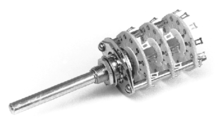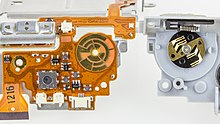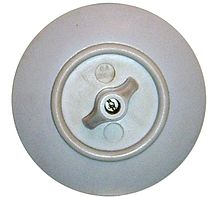Rotary switch
A rotary switch is a special switch used in electrical engineering to set switching states by means of a mechanical rotary movement. In the process, one or more circuits are switched on or off together by various contact arrangements in the form of a rotary movement triggered by the operator. In a multi-pole rotary switch for low voltage, as shown in the adjacent figure, the individual contact fields are arranged on a common axis; the contacts are moved together by the rotational movement of the axis.
Rotary switches are available in different, usually very application-specific designs such as single or multi-pole, with or without stop, for specific switching sequences or also for binary coding. Concrete examples of rotary switches are:
- Rotary switches that are mechanically combined with a potentiometer on the rotary axis. This form is found, for example, in some radios where the on switch is combined as a rotary switch with the volume control (potentiometer).
- Single-pole rotary switches were also used as light switches in domestic installations, especially until the middle of the 20th century, before they were largely replaced by the toggle switches common today. The expression "turning the light on or off", which still originates from the times of petroleum lamp and gas light, was also carried over into the era of electrification by the rotary switch and is still used today, especially in southern Germany and Austria.
- Multi-pole rotary switches that have certain states or state sequences mechanically coded and are used in electronic devices for configuration. Examples of applications are older TV receivers from the 1960-1970s, where the channel selector switch is implemented as a rotary switch. For address setting of bus-bound or wireless electronic modules and devices they are more convenient than DIP switches or jumpers.
- In the field of power engineering for older electric rail vehicles: rotary switch for setting different travel speeds or drive powers
- Also used in power engineering for switching transformer taps for automatic adjustment of the medium voltage level in transformer substations, motor-driven
- In measuring instruments such as multimeters and older oscilloscopes, they are used to select calibrated measuring ranges.
- Cam switch as main switch for manual switching of electrical consumers.
Depending on the contact design, a distinction can be made between "wiping" and "interrupting" contacts; this also applies in principle to changeover switches. A "wiping contact" is understood to be a short circuit of two adjacent contacts with the wiper during switching. In the opposite case, there is no such short circuit.
Many of the modular rotary switches, as in the illustration, are equipped with wiping contacts; interrupting behaviour results from omitting and mechanically skipping the intermediate contact. In power engineering, for switching transformer taps, such an intermediate contact is wired with bucket-sized power resistors. On the other hand, wiping behaviour is unusual with changeover switches and fixed rotary switches. Attention may need to be paid to this in circuit design to avoid hazards.

Rotary switch in multipole version

Rotary switch of a compact camera, disassembled: left the contact surfaces, right the sliding contacts

modern rotary switch, as an alternative to the usual light switch
See also
- Series connection for the rotary series switch
Search within the encyclopedia